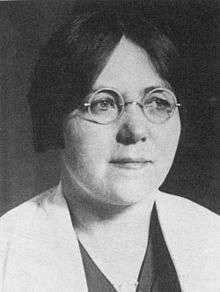Mary Broadfoot Walker
| Mary Broadfoot Walker | |
|---|---|
 Dr Mary Walker in the 1920s | |
| Born |
17 April 1888 Croft-an-Righ, Wigtown, Scotland |
| Died | 13 September 1974 (aged 86) |
| Education |
University of Glasgow Edinburgh School of Medicine for Women |
| Years active | 1913–1974 |
| Known for |
Treatment of myasthenia gravis with physostigmine Association of familial periodic paralysis and hypokalaemia |
| Medical career | |
| Profession | physician |
| Institutions |
St Alfege's Hospital, Greenwich St Leonard's Hospital, Shoreditch St Francis' Hospital, Dulwich St Benedict's Hospital, Tooting Glasgow Royal Maternity and Women's Hospital |
| Research |
Myasthenia gravis Familial periodic paralysis |
| Notable prizes | Royal College of Physicians Jean Hunter Prize (1962) |
Mary Broadfoot Walker (17 April 1888 – 13 September 1974) was a Scottish physician who first demonstrated the effectiveness of physostigmine in the treatment of the condition myasthenia gravis, a disease relating to muscle weakness. She was also the first to recognise the association between familial periodic paralysis and low blood potassium levels.
Biography
Mary Walker was born at Croft-an-Righ, Wigtown, Scotland in 1888, one of four children and the daughter of a judge. After school she trained in medicine at the University of Glasgow and Edinburgh School of Medicine for Women, graduating with MBChB in 1913. During the First World War she served with the Royal Army Medical Corps at the 63rd General Hospital, Malta.[1] In 1920 she became a salaried Assistant Medical Officer in "Poor Law Service" at St Alfege's Hospital, Greenwich, London, where she worked until 1936.[2] In 1932 she was awarded Membership of the Royal College of Physicians. She then worked at St. Leonard's Hospital, Shoreditch, St. Francis' Hospital, Dulwich and St. Benedict's Hospital, Tooting, before retiring to Croft-an-Righ in 1954.
In 1934, while working at St Alfege's Hospital, Walker discovered that the subcutaneous injection of physostigmine could temporarily reverse the muscle weakness found in patients suffering from myasthenia gravis. She had noted that the symptoms and signs of myasthenia were similar to those found in curare poisoning, and physostigmine was used as an antidote to curare poisoning at that time.[3] The first case of myasthenia gravis successfully treated with physostigmine was published in the Lancet in June 1934.[4]
In 1935 Walker was the first to recognise the association between the condition familial periodic paralysis and hypokalaemia (low blood potassium levels).[5] She also described the glucose challenge test used in diagnosing hypokalaemic periodic paralysis and the use of intravenous potassium in its treatment.[6] During 1935 her research on myasthenia was incorporated into her MD thesis which was submitted via the University of Edinburgh[7], and for which she received a Gold Medal.[8]
After her retirement in 1954 she continued to work part-time at the Glasgow Royal Maternity and Women's Hospital, and remained active in the field of myasthenia gravis.[9][10]
In 1962 Walker was the first recipient of the Royal College of Physicians Jean Hunter Prize "for the advancement of research into the treatment of nervous exhaustion and for her original contribution to the fundamental knowledge of the nature of myasthenia gravis, made while carrying out the routine duties of a medical officer at a large metropolitan hospital". [11]
Her 1973 article also describes the Mary Walker Effect, a clinical sign found in myasthenia gravis.[10]
She died on 13 September 1974 at the age of 86.[12]
References
- ↑ Pearce JM (2005). "Mary Broadfoot Walker (1888–1974): a historic discovery in myasthenia gravis". Eur. Neurol. 53 (1): 51–3. doi:10.1159/000084268. PMID 15746548.
- ↑ Johnston JD (September 2007). "Mary Broadfoot Walker (1888–1974)". J. Neurol. 254 (9): 1306–7. doi:10.1007/s00415-007-0663-z. PMID 18000738.
- ↑ "Dr Mary Walker – A Pioneer in the Treatment of Myasthenia Gravis". MG -association UK. Retrieved 23 November 2008.
- ↑ Walker MB (1934). "Treatment of myasthenia gravis with physostigmine". Lancet. 1 (5779): 1200–1201. doi:10.1016/S0140-6736(00)94294-6.
- ↑ Walker MB (1935). "Potassium chloride in myasthenia gravis". Lancet. 2 (5836): 47. doi:10.1016/S0140-6736(01)09382-5.
- ↑ Aitken RS, Allot EN, Gastelden LI, Walker MB (1937). "Observations on a case of familial periodic paralysis". Clin Sci. 3: 47–57.
- ↑ Broadfoot, Walker, Mary (1935). "Contribution to the study of Myasthenia Gravis".
- ↑ Edinburgh University Calendar 1937–1938. Edinburgh: James Thin. 1937. p. 581.
- ↑ Letter to Miss Sylvia Bates advocating controlled trial of thymectomy to ascertain its role in the management of myasthenia gravis
- 1 2 Walker MB (April 1973). "Some discoveries on myasthenia gravis: the background". Br Med J. 2 (5857): 42–3. doi:10.1136/bmj.2.5857.42. PMC 1588990. PMID 4572033.
- ↑ Encyclopedia of the Neurological Sciences. Academic Press. 2014-04-29. ISBN 9780123851581.
- ↑ "Obituary". Lancet. 304 (7893): 1401. 1974. doi:10.1016/S0140-6736(74)92285-5.
External links
| Wikimedia Commons has media related to Mary Walker. |